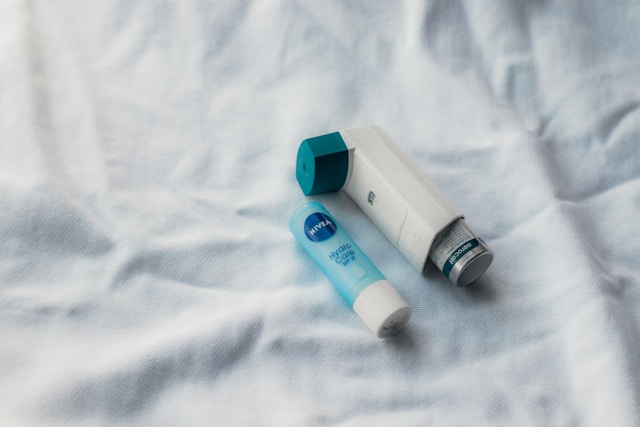
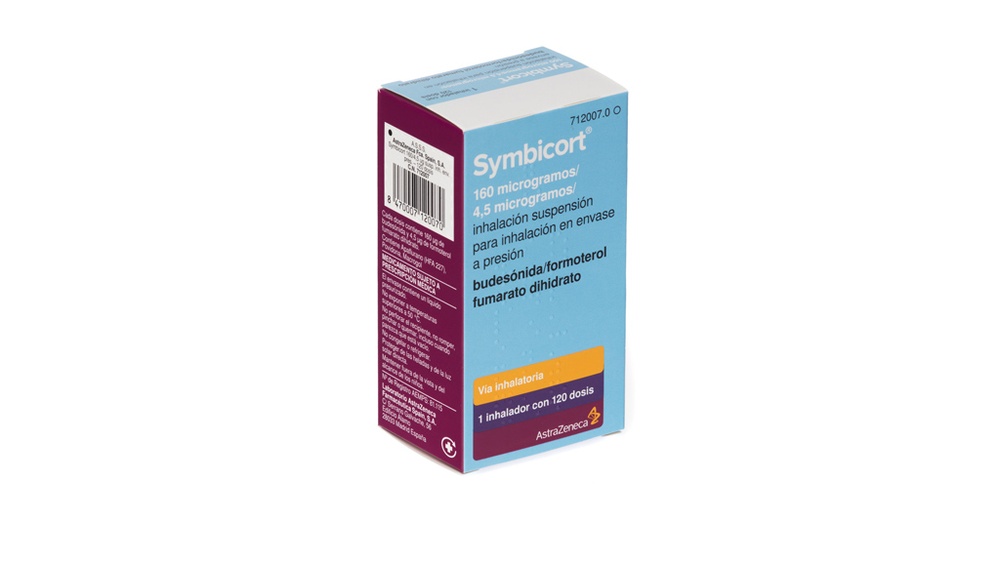
SYMBICORT 160 microgramas/4,5 microgramas/inalação suspensão pressurizada para inalação

Pergunte a um médico sobre a prescrição de SYMBICORT 160 microgramas/4,5 microgramas/inalação suspensão pressurizada para inalação

Como usar SYMBICORT 160 microgramas/4,5 microgramas/inalação suspensão pressurizada para inalação
Introdução
Prospecto: informação para o utilizador
Symbicort 160 microgramas/4,5 microgramas/inhalação suspensão para inhalação em embalagem a pressão
Budesonida/formoterol fumarato dihidrato
Leia todo o prospecto atentamente antes de começar a usar este medicamento, porque contém informações importantes para si.
- Conserva este prospecto, porque pode ter que o ler novamente.
- Se tiver alguma dúvida, consulte o seu médico ou farmacêutico.
- Este medicamento foi prescrito apenas para si, e não deve dá-lo a outras pessoas, mesmo que tenham os mesmos sintomas que si, porque pode prejudicá-las.
- Se experimentar efeitos adversos, consulte o seu médico ou farmacêutico, mesmo que se trate de efeitos adversos que não aparecem neste prospecto. Ver seção 4.
Conteúdo do prospecto
- O que é Symbicort e para que é utilizado
- O que precisa saber antes de começar a usar Symbicort
- Como usar Symbicort
- Possíveis efeitos adversos
- Conservação de Symbicort
- Conteúdo da embalagem e informações adicionais
1. O que é Symbicort e para que é utilizado
Symbicort é um inhalador que é utilizado para o tratamento sintomático da Doença Pulmonar Obstrutiva Crónica (DPOC) em adultos maiores de 18 anos. A DPOC é uma doença crónica das vias respiratórias dos pulmões, causada frequentemente pelo fumo do tabaco. Contém dois medicamentos diferentes: budesonida e formoterol fumarato dihidrato.
- A budesonida pertence a um grupo de medicamentos denominados “corticosteroides”, e actua reduzindo e prevenindo a inflamação dos pulmões.
- O formoterol fumarato dihidrato pertence a um grupo de medicamentos denominados “agonistas beta2 adrenérgicos de acção longa” ou “broncodilatadores”, e actua relaxando os músculos das vias respiratórias, o que ajuda a respirar mais facilmente.
Não use este medicamento como inhalador “de alívio”.
2. O que precisa saber antes de começar a usar Symbicort
Não use Symbicort:
- se é alérgico à budesonida, ao formoterol ou a algum dos outros componentes deste medicamento (incluídos na seção 6).
Advertências e precauções
Consulte o seu médico ou farmacêutico antes de começar a usar Symbicort se:
- Têm diabetes.
- Apresenta alguma infecção pulmonar.
- Têm a tensão arterial alta, ou alguma vez teve alguma doença de coração (incluyendo latidos irregulares, pulso acelerado, estreitamento das artérias ou insuficiência cardíaca).
- Têm problemas de tiróide ou das glândulas suprarrenais.
- Apresenta níveis baixos de potássio no sangue.
- Têm problemas graves de fígado.
Entre em contacto com o seu médico se apresentar visão borrosa ou outras alterações visuais.
Uso em desportistas
Este medicamento contém formoterol, que pode produzir um resultado positivo nos testes de controlo de dopagem.
Crianças e adolescentes
Symbicort não é recomendado em crianças ou adolescentes menores de 18 anos.
Outros medicamentos e Symbicort
Informa o seu médico ou farmacêutico se está a utilizar, utilizou recentemente ou pode ter que utilizar qualquer outro medicamento.
Em particular, informa o seu médico ou farmacêutico se está a usar algum dos seguintes medicamentos:
- Medicamentos beta-bloqueantes (como o atenolol e o propranolol para a tensão arterial alta), incluyendo colírios (como o timolol para o glaucoma).
- Medicamentos para tratar o ritmo cardíaco acelerado ou irregular (por exemplo quinidina).
- Medicamentos como a digoxina, utilizados habitualmente para tratar a insuficiência cardíaca.
- Diuréticos (como a furosemida), utilizados para o tratamento da tensão arterial alta.
- Medicamentos esteroides tomados por via oral (como a prednisolona).
- Medicamentos xantínicos (como teofilina ou aminofilina), utilizados comumente para o tratamento da DPOC ou do asma.
- Outros broncodilatadores (como salbutamol).
- Antidepresivos tricíclicos (como amitriptilina) e o antidepresivo nefazodona.
- Medicamentos fenotiazínicos (como clorpromazina e proclorperazina).
- Medicamentos denominados “inibidores da protease do VIH” (como ritonavir) para o tratamento do vírus do SIDA.
- Medicamentos para tratar infecções (como ketoconazol, itraconazol, voriconazol, posaconazol, claritromicina e telitromicina).
- Medicamentos para o tratamento do Parkinson (como a levo-dopa).
- Medicamentos para problemas de tiróide (como a levo-tiroxina).
Se se encontrar em alguma dessas situações, ou se não tiver certeza, pergunte ao seu médico ou farmacêutico antes de utilizar Symbicort.
Informa também ao seu médico ou farmacêutico se vai ser submetido a anestesia geral por uma operação cirúrgica ou por tratamento dentário.
Gravidez, amamentação e fertilidade
- Informa ao seu médico antes de usar este medicamento se está grávida, ou planeia estar; não utilize Symbicort a menos que o seu médico o indique.
- Em caso de ficar grávida durante o tratamento com Symbicort, não deixe de utilizar e consulte com o seu médico imediatamente.
- Se se encontrar em período de amamentação, fale com o seu médico antes de utilizar Symbicort.
Condução e uso de máquinas
A influência de Symbicort sobre a capacidade de conduzir e de manejar máquinas é nula ou insignificante.
3. Como usar Symbicort
- Siga exactamente as instruções de administração deste medicamento indicadas pelo seu médico ou farmacêutico. Em caso de dúvida, consulte novamente o seu médico ou farmacêutico.
- É importante utilizar Symbicort diariamente, mesmo que não apresente sintomas de DPOC nesse momento.
A dose recomendada é de 2 inalações duas vezes ao dia. Não é recomendado o uso de Symbicort em crianças ou adolescentes menores de 18 anos de idade.
Se esteve a tomar comprimidos de esteroides para a DPOC, o seu médico pode reduzir o número de comprimidos que toma, uma vez que comece o tratamento com Symbicort. Se esteve a tomar comprimidos de esteroides orais durante muito tempo, o seu médico pode querer fazer-lhe um análise de sangue de vez em quando. Quando lhe for reduzido o número de comprimidos de esteroides orais pode sentir mal-estar geral, mesmo que os seus sintomas pulmonares possam estar a melhorar. Nesse caso, pode que apareçam temporariamente alguns sintomas como congestão ou goteo nasal, fraqueza ou dor nos músculos ou nas articulações e erupção cutânea (urticária). Entre em contacto com o seu médico se algum desses sintomas o preocupa, ou apresenta algum outro sintoma como dor de cabeça, cansaço, náuseas ou vómitos. Se aparecerem sintomas de alergia ou de artrite, pode que necessite de tomar outro medicamento. Deve consultar com o seu médico se está preocupado acerca de se deve continuar a usar Symbicort.
O seu médico pode considerar adicionar comprimidos de esteroides ao seu tratamento habitual durante os períodos de stresse (por exemplo, quando tem uma infecção no peito ou antes de uma operação).
Informação importante sobre os sintomas de DPOC
Se enquanto utiliza Symbicort sentir dificuldade para respirar ou aparecerem “pitos” com a respiração, deve continuar a utilizá-lo e contactar com o seu médico o mais breve possível, porque pode necessitar de um tratamento adicional.
Entre em contacto imediatamente com o seu médico se:
- A sua respiração piora ou acorda frequentemente à noite com sintomas de falta de ar.
- Começa a sentir opressão no peito pela manhã, ou a opressão no peito se prolonga mais do que o normal.
- Estes sinais podem indicar que não há um bom controlo da sua DPOC e pode que necessite imediatamente de um tratamento diferente ou adicional.
É possível que o seu médico lhe prescreva outros broncodilatadores, por exemplo anticolinérgicos (como tiotrópio ou brometo de ipratrópio) para a DPOC.
Informação sobre o seu novo inhalador Symbicort
- Antes de utilizar o seu novo inhalador de Symbicort, retire-o da embalagem de papel de alumínio. Jogue fora a embalagem, bem como o agente dessecante que está dentro da embalagem. Não utilize o inhalador se o agente dessecante se tiver saído do pacote.
- O inhalador deve ser utilizado dentro dos 3 meses seguintes após ter sido retirado da embalagem de papel de alumínio. Escreva na etiqueta do inhalador a data limite de uso (3 meses a partir de ter sido retirado da embalagem), para lembrar-lhe quando deve deixar de usar o inhalador.
- Na imagem são mostradas as partes de que está composto o inhalador, que já estará montado quando lhe for dado. Não separe as peças. Se o recipiente se afrouxar, volte a colocá-lo no inhalador e continue a utilizá-lo.
Preparação de Symbicort
É necessário preparar o inhalador para o seu uso nas seguintes situações:
- Se está a utilizar o seu novo Symbicort pela primeira vez.
- Se não o utilizou durante mais de 7 dias.
- Se lhe caiu.
Para preparar o inhalador para o seu uso, siga as seguintes instruções:
- Agite bem o inhalador durante pelo menos 5 segundos para misturar o conteúdo do cartucho do aerosol.
- Retire a tampa da boquilha pressionando ligeiramente sobre as protuberâncias laterais. A tira da tampa ficará unida ao inhalador.
- Sustenha o inhalador na posição vertical. Em seguida, pressione o contador (na parte superior do inhalador) para libertar uma pulverização ao ar. Pode utilizar uma ou ambas as mãos, como se mostra nas fotos.
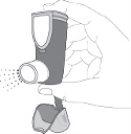
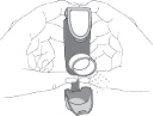
- Retire o dedo (s) do contador.
- Espere 10 segundos, agite bem e repita os passos 3 e 4.
- O seu inhalador está agora pronto para o seu uso.
Como realizar uma inalação
Cada vez que necessitar realizar uma inalação, siga estas instruções:
- Agite bem o inhalador durante pelo menos 5 segundos para misturar o conteúdo do cartucho do aerosol.
- Retire a tampa da boquilha pressionando ligeiramente sobre as protuberâncias laterais. Verifique que a boquilha não está bloqueada.
- Sustenha o inhalador na posição vertical (pode usar uma ou as duas mãos). Expulse o ar suavemente.
- Coloque suavemente a boquilha entre os dentes. Feche os lábios.
- Inspire lentamente e profundamente através da boca. Pressione firmemente o contador (na parte de cima do inhalador) para libertar uma pulverização. Retenha o ar por um momento enquanto pressiona o contador. Inspire ao mesmo tempo que pressiona o contador para garantir que o medicamento chegue aos pulmões.
- Mantenha a respiração durante 10 segundos, ou o máximo tempo que lhe for confortável.
- Antes de expulsar o ar, solte o dedo do contador e retire o inhalador da boca. Mantenha o inhalador na posição vertical.
 Expulse o ar suavemente. Antes de fazer outra inalação, agite bem o inhalador durante pelo menos 5 segundos e repita os passos do 3 ao 7.
Expulse o ar suavemente. Antes de fazer outra inalação, agite bem o inhalador durante pelo menos 5 segundos e repita os passos do 3 ao 7.- Cubra novamente a boquilha.
- Enxágue a boca com água após as duas doses diárias da manhã e da noite. Não a engula.
Uso de câmara espaciadora
O seu médico, enfermeiro ou farmacêutico pode sugerir-lhe o uso de uma câmara espaciadora (por exemplo, Aerochamber Plus Flow VuouAerochamber Plus). Siga as instruções que figuram no prospecto incluído com a câmara espaciadora.
Limpeza de Symbicort
- Limpe o interior e exterior da boquilha pelo menos uma vez por semana com um pano seco.
- Não utilize água ou líquidos e não separe o cartucho do inhalador.
Como pode saber quando tem que substituir o seu inhalador Symbicort?
- O contador da parte superior diz-lhe quantas inalações restam no seu inhalador Symbicort. Começa com 120 inalações quando está cheio.
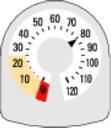
- Cada vez que realiza uma inalação, ou a liberta ao ar, a seta começa uma contagem decrescente para o zero ('0').
- Quando a seta entra pela primeira vez na área amarela, significa que restam cerca de 20 inalações.
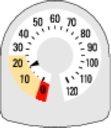
- Quando a seta chega ao '0', deve deixar de usar o seu novo inhalador Symbicort. Pode que não tenha a sensação de que o inhalador está vazio e que pareça que ainda funciona, mas não receberá a quantidade correcta do medicamento se continuar a usá-lo.
Se usar mais Symbicort do que deve
Se utilizou mais Symbicort do que devia, contacte o seu médico ou farmacêutico. Os sintomas e sinais mais habituais que podem ocorrer após uma sobredose são tremores, dor de cabeça e batimentos rápidos do coração.
Em caso de sobredose ou ingestão acidental, consulte o Serviço de Informação Toxicológica. Telefone: 91 5620420, indicando o medicamento e a quantidade ingerida.
Se esqueceu de usar Symbicort
- Se esqueceu de alguma das doses de Symbicort, siga o tratamento recomendado assim que se lembrar. No entanto, se for quase a hora da sua próxima dose, não se preocupe com a dose esquecida.
- Nãouse uma dose dupla para compensar as doses esquecidas.
Se interromper o tratamento com Symbicort
Antes de deixar de utilizar Symbicort, deve consultar o médico ou o farmacêutico. Se deixar de utilizar Symbicort os sintomas e sinais da DPOC podem piorar.
Se tiver alguma outra dúvida sobre o uso deste medicamento, pergunte ao seu médico ou farmacêutico.
4. Possíveis efeitos adversos
Como todos os medicamentos, este medicamento pode produzir efeitos adversos, embora nem todas as pessoas os sofram.
Se lhe ocorrer alguma das seguintes situações, deixe de utilizar Symbicort e consulte imediatamente o seu médico:
- Se o seu rosto se inflamar, particularmente ao redor da boca (língua e/ou garganta e/ou dificuldade para engolir) ou aparecer urticária juntamente com dificuldades para respirar (angioedema) e/ou nota uma sensação súbita de desfalecimento, o que indica que pode estar a sofrer uma reação alérgica. Isto ocorre raramente, afetando menos de 1 em cada 1.000 doentes.
- Têm “pitos” agudos ou dificuldade para respirar imediatamente após usar o seu inhalador. Se lhe suceder algum destes sintomas, deixe de utilizar imediatamente Symbicort e use o seu “inhalador de alívio”. Entre em contacto imediatamente com o seu médico, porque pode que seja necessário alterar o seu tratamento.Isto ocorre muito raramente, afetando menos de 1 em cada 10.000 doentes.
Outros possíveis efeitos adversos:
Frequentes (podem afetar até 1 em cada 10 doentes)
- Palpitações (notar os batimentos do coração), tremores ou arrepios. Estes efeitos, se ocorrerem, são geralmente leves e desaparecem à medida que se vai utilizando Symbicort.
- Muguet (infecção por fungos) na boca; este efeito é menos provável se limpar a boca com água após utilizar Symbicort.
- Irritação ligeira de garganta, tosse, rouquidão.
- Dor de cabeça.
- Pneumonia (infecção nos pulmões) em doentes com DPOC.
Informa ao seu médico se tem algum dos seguintes sintomas enquanto inhala Symbicort, podem ser sintomas de uma infecção pulmonar:
- Febre ou arrepios.
- Aumento da produção de muco, alteração na cor do muco.
- Aumento da tosse ou aumento de dificuldades para respirar.
Pouco frequentes (podem afetar até 1 em cada 100 doentes)
- Agitação, inquietude, nervosismo.
- Dificuldade para dormir.
- Tonturas.
- Náuseas (enjoo).
- Ritmo cardíaco acelerado.
- Hematomas na pele.
- Cãibras musculares.
- Visão borrosa.
Raros (podem afetar até 1 em cada 1.000 doentes)
- Erupção, prurido.
- Broncoespasmo (contracção dos músculos das vias respiratórias, o que provoca “pitos”). Se os pitos ocorrerem subitamente logo após utilizar Symbicort, deixe de utilizá-lo e consulte o seu médico imediatamente.
- Níveis baixos de potássio no sangue.
- Latido cardíaco irregular.
Muito raros (podem afetar até 1 em cada 10.000 doentes)
- Depressão.
- Alterações do comportamento, especialmente em crianças.
- Dor ou opressão no peito (angina de peito).
- Aumento na quantidade de açúcar (glicose) no sangue.
- Alterações do paladar, como sabor de boca desagradável.
- Variações na tensão arterial.
Os corticoides inhalados podem afetar a produção normal de hormonas esteroides no organismo, especialmente se forem utilizadas doses elevadas durante muito tempo. Estes efeitos incluem:
- alterações na densidade mineral óssea (adelgaçamento dos ossos)
- cataratas (perda de transparência do cristalino no olho)
- glaucoma (aumento da pressão ocular)
- atraso do crescimento em crianças e adolescentes
- efeitos sobre as glândulas suprarrenais (glândulas de pequeno tamanho situadas junto aos rins).
Estes efeitos são muito menos prováveis com os corticoides inhalados do que com os comprimidos de corticoides.
Comunicação de efeitos adversos
Se experimentar algum tipo de efeito adverso, consulte o seu médico ou farmacêutico, mesmo que se trate de possíveis efeitos adversos que não aparecem neste prospecto. Também pode comunicá-los directamente através do Sistema Español de Farmacovigilancia de medicamentos de Uso Humano: www.notificaRAM.es. Mediante a comunicação de efeitos adversos, pode contribuir para proporcionar mais informações sobre a segurança deste medicamento.
5. Conservação de Symbicort
- Mantenha este medicamento fora da vista e do alcance das crianças.
- Não utilize este medicamento após a data de validade que aparece no cartonagem, no sobre de alumínio ou na etiqueta após CAD. A data de validade é o último dia do mês que se indica.
- Assim como com a maioria dos medicamentos inhalados em envases a pressão, o efeito deste medicamento pode diminuir quando o envase está frio. Para obter os melhores resultados, este medicamento deve estar à temperatura ambiente antes de seu uso. Não refrigerar ou congelar. Proteger das geadas e da luz solar direta.
- Deverá ser utilizado dentro dos 3 meses seguintes após ter retirado o inhalador de sua embalagem de alumínio. Escreva a data de validade (3 meses a partir da abertura da embalagem) na etiqueta do inhalador para lembrar quando deve deixar de usar o inhalador.
- Volte a colocar sempre a tampa da boquilla e encaixe-a em sua posição após usar o inhalador.
- Os medicamentos não devem ser jogados nos deságues nem na lixeira. Deposite os envases e os medicamentos que não precisa no Ponto SIGRE da farmácia. Pergunte ao seu farmacêutico como se livrar dos envases e dos medicamentos que não precisa. Dessa forma, ajudará a proteger o meio ambiente.
Aviso: O cartucho contém um líquido pressurizado. Não exponha a temperaturas superiores a 50 °C. Não perfure o recipiente. O cartucho não deve ser rompido, perfurado ou queimado, mesmo quando pareça que está vazio.
6. Conteúdo do envase e informação adicional
Composição de Symbicort
Os princípios ativos são budesonida e formoterol fumarato di-hidratado. Cada dose inhalada contém 160 microgramas de budesonida e 4,5 microgramas de formoterol fumarato di-hidratado.
Os demais excipientes são apaflurano (HFA 227), povidona e Macrogol. Este inhalador não contém CFCs.
Este medicamento contém gases fluorados de efeito estufa. Cada inhalador contém 10,6 g de apaflurano (HFC-227ea) que correspondem a 0,034 toneladas de CO2 equivalente (potencial de aquecimento global PCG = 3 220).
Aspecto do produto e conteúdo do envase
Symbicort é um inhalador que contém seu medicamento. O cartucho a pressão com indicador de dose adjunto, contém uma suspensão de cor branca para a inalação. O cartucho está montado em um adaptador de plástico de cor vermelha com uma boquilla de plástico branca e uma tampa de plástico cinza integrada. Cada inhalador contém 120 inalações após ter sido preparado para seu uso. Cada inhalador é embalado individualmente em uma embalagem de papel de alumínio que contém um agente dessecante.
Symbicort 160 microgramas/4,5 microgramas / inalação suspensão para inalação em envase a pressão (budesonida/formoterol fumarato di-hidratado) está disponível em envases com um único inhalador.
Título da autorização de comercialização e responsável pela fabricação
O titular é:
Laboratório AstraZeneca Farmacêutica Spain, S.A.
C/ Puerto de Somport 21-23
28050 Madrid
Espanha
O responsável pela fabricação é:
AstraZeneca Dunkerque Production
224, Avenue de la Dordogne BP 41
59640 Dunkerque (França)
Este medicamento está autorizado nos estados membros do Espaço Econômico Europeu com os seguintes nomes:
País | Nome comercial e concentração |
Alemanha | Symbicort 160 Mikrogramm /4,5 Mikrogramm pro Inhalation Druckgasinhalation, Suspension |
Áustria | Symbicort 160 Mikrogramm /4,5 Mikrogramm/Inhalation Druckgasinhalation, Suspension |
Bélgica | Symbicort 160 microgram /4,5 microgram/inhalatie, aërosol, suspensie Symbicort 160 microgrammes /4,5 microgrammes/inhalation, suspension pour inhalation en flacon pressurisé Symbicort 160 Mikrogramm /4,5 Mikrogramm/Inhalation, Druckgasinhalation, Suspension |
Bulgária | ????????? 160 ?????????? /4,5 ??????????/?????????? ????????? ??? ???????? ?? ????????? |
Chipre | Symbicort 160 μικρογραμμ?ρια /4,5 μικρογραμμ?ρια/ψεκασμ? |
Croácia | Symbicort 160 mikrograma /4,5 mikrograma po potisku, stlaceni inhalat, suspenzija |
Dinamarca | Symbicort 160 mikrogram /4.5 mikrogram/inhalation |
Eslováquia | Symbicort 160 mikrogamov /4,5 mikrogamov/inhalacná dávka |
Eslovênia | Symbicort 160 mikrogramov /4,5 mikrograma na vdih, inhalacijska suspenzija pod tlakom |
Espanha | Symbicort 160 microgramos /4,5 microgramos/inhalación suspensão para inhalación en envase a presión |
Estônia | Symbicort |
Finlândia | Symbicort 160 mikrog /4.5 mikrog/inhalaatio |
França | Symbicort 200 micro grammes /6 micro grammes par inhalation |
Grécia | Symbicort 160 μικρογραμμ?ρια /4,5 μικρογραμμ?ρια/ψεκασμ? |
Holanda | Symbicort 200/6, 200 microgram /6 microgram/inhalatie |
Hungria | Symbicort 4,5 mikrogramm /160 mikrogramm túlnyomásos inhalációs szuszpenzió |
Irlanda | Symbicort 200 micrograms /6 micrograms/inhalation |
Islândia | Symbicort 160 míkrógrömm /4,5 míkrógrömm/ inhalation |
Itália | Symbicort 160 microgrammi /4,5 microgrammi/erogazione, sospensione pressurizzata per inalazione |
Letônia | Symbicort 160 mikrogrami /4.5 mikrogrami/ inhalacija, izsmidzinajuma, aerosols inhalacijam zem spiediena |
Lituânia | Symbicort 160 mikrogramu /4,5 mikrogramo/išpurškime suslegtoji ikvepiamoji suspensija |
Luxemburgo | Symbicort 160 microgrammes /4,5 microgrammes/inhalation, suspension pour inhalation en flacon pressurisé |
Malta | Symbicort 200 micrograms /6 micrograms/inhalation |
Noruega | Symbicort 160 mikrogram /4.5 mikrogram/ inhalasjon |
Polônia | Symbicort |
Portugal | Symbicort 160 microgramas /4,5 microgramas/inalação Suspensão pressurizada para inalação |
Reino Unido | Symbicort 200 micrograms/6 micrograms per actuation pressurised inhalation, suspension |
República Checa | Symbicort 160 mikrogramu /4,5 mikrogramu |
Romênia | Symbicort 160 micrograme /4.5 micrograme/inhalatie, suspensie de inhalat presurizata |
Suécia | Symbicort 160 mikrogram /4.5 mikrogram/inhalation |
Data da última revisão deste prospecto: Janeiro 2025
A informação detalhada deste medicamento está disponível na página web da Agência Espanhola de Medicamentos e Produtos Sanitários (AEMPS) http://www.aemps.gob.es/

Quanto custa o SYMBICORT 160 microgramas/4,5 microgramas/inalação suspensão pressurizada para inalação em Espanha em 2025?
O preço médio do SYMBICORT 160 microgramas/4,5 microgramas/inalação suspensão pressurizada para inalação em dezembro de 2025 é de cerca de 39.56 EUR. Os valores podem variar consoante a região, a farmácia e a necessidade de receita. Confirme sempre com uma farmácia local ou fonte online para obter informações atualizadas.
- País de registo
- Preço médio em farmácia39.56 EUR
- Substância ativa
- Requer receita médicaSim
- Fabricante
- Esta informação é apenas para referência e não constitui aconselhamento médico. Consulte sempre um médico antes de tomar qualquer medicamento. A Oladoctor não se responsabiliza por decisões médicas baseadas neste conteúdo.
- Alternativas a SYMBICORT 160 microgramas/4,5 microgramas/inalação suspensão pressurizada para inalaçãoForma farmacêutica: INALAÇÃO PULMONAR, 160 microgramas / 4,5 microgramasSubstância ativa: formoterol and budesonideFabricante: Teva Pharma B.V.Requer receita médicaForma farmacêutica: INALAÇÃO PULMONAR, 320 microgramas / 9 microgramasSubstância ativa: formoterol and budesonideFabricante: Teva Pharma B.V.Requer receita médicaForma farmacêutica: INALAÇÃO PULMONAR, 160 MICROGRAMAS/4,5 MICROGRAMASSubstância ativa: formoterol and budesonideFabricante: Cipla Europe N.V.Requer receita médica
Alternativas a SYMBICORT 160 microgramas/4,5 microgramas/inalação suspensão pressurizada para inalação noutros países
As melhores alternativas com o mesmo princípio ativo e efeito terapêutico.
Alternativa a SYMBICORT 160 microgramas/4,5 microgramas/inalação suspensão pressurizada para inalação em Polonia
Alternativa a SYMBICORT 160 microgramas/4,5 microgramas/inalação suspensão pressurizada para inalação em Ucrania
Médicos online para SYMBICORT 160 microgramas/4,5 microgramas/inalação suspensão pressurizada para inalação
Avaliação de posologia, efeitos secundários, interações, contraindicações e renovação da receita de SYMBICORT 160 microgramas/4,5 microgramas/inalação suspensão pressurizada para inalação – sujeita a avaliação médica e regras locais.





